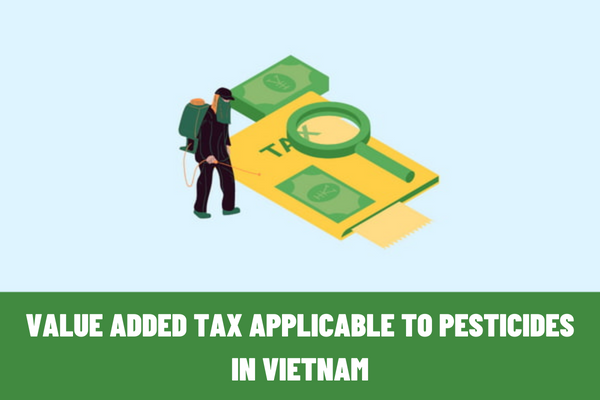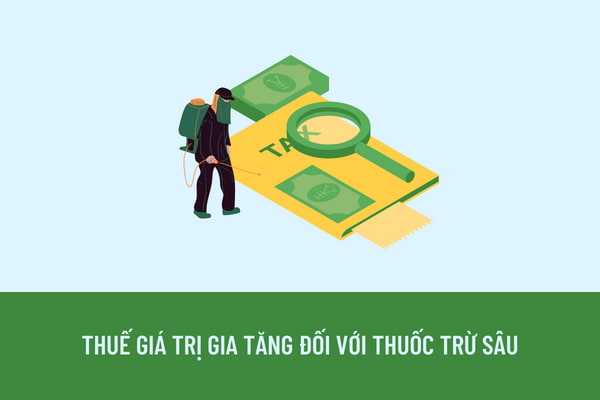On what basis is value added tax calculated? How many tax rates must be paid for trading in pesticides and plant protection drugs in Vietnam?
On what basis is VAT calculated?
Pursuant to Article 6 of Circular No. 219/2013/TT-BTC stipulating as follows:
Tax basis
Tax basis is taxable prices and tax rates.
Thus, the formula for calculating value added tax will be implemented as follows:
Value-added tax = value-added taxable price x value-added tax rate
According to that, Article 7 of Circular No. 219/2013/TT-BTC stipulates each specific case to determine the taxable prices.
Which subjects is the tax rate of 5% applicable to?
According to the provisions of Article 10 of Circular No. 219/2013/TT-BTC (amended, supplemented, and annulled a number of goods according to Article 1 of Circular No. 26/2015/TT-BTC and Article 1 of Circular No. 43/2021/TT-BTC) including 14 groups of goods and services subject to the VAT rate of 5%. Specifically, the tax rate of 5% applies to:
- Clean water serving manufacture and everyday life, except for bottled water and other soft drinks subject to 10% tax rate.
- Ores used for fertilizer manufacture; pesticides and growth stimulants for plants and animals, including:
+ Ores used for manufacture of fertilizers such as apatite ore used for manufacture of phosphate fertilizers, humus used as biofertilizers;
+ Pesticides include plant protection drugs on the List of plant protection drugs in Vietnam issued by those in the List of pesticides compiled by the Ministry of Agriculture and Rural Development and other pesticides;
+ Growth stimulants for plants and animals.
- Dredging channels, canals, ponds, and lakes serving agriculture; plant cultivation; preprocessing and preservation of agricultural products. Preprocessing and preservation of agricultural products include drying, husking, threshing, cutting, grinding, putting into cold storage, salting, and other usual means of preservation.
- The farming, breeding, aquaculture products that are unprocessed or preprocessed, except for the cases in Clause 5 Article 5 of Circular No. 219/2013/TT-BTC. The unprocessed farming products mentioned in this Clause include unhusked rice, husked rice, corn, potatoes, cassava, and wheat.
- Latex and resin that have undergone insufficient processing; fishing nets and fibers for making fishing nets regardless of materials.
- Fresh foods for business, unprocessed forestry products for business, except for wood, bamboo sprouts, and the products enumerated in Clause 1 Article 4 of Circular No. 219/2013/TT-BTC. Fresh foods include the foods that have not been cooked or processed into other products, or have only been cleaned, unhusked, cut, frozen, or dried in a way that they are still fresh foods such as meat of livestock and poultry, shrimps, crabs, fish, and other aquaculture products. 10% tax shall be levied on seasoned foods. Unprocessed forestry products include the products from natural forests such as rattan, bamboo, mushrooms, roots, leaves, flowers, herbs, resin, and other forestry products. The seasoned triggerfish is subject to 10% VAT.
- Sugar; by-products during the sugar manufacture process including molasses, bagasse.
- Products made of jute, rattan, bamboo, leaves, straws, coconut shells, hyacinth, and other handicrafts made of recycled materials from agriculture; preprocessed cotton; newspaper printing paper.
- Medical equipment and tools including medical machines and equipment: screening, scanning and imaging equipment for medical examination and treatment; specialized equipment for surgery, treatment, emergency medical service vehicle; measuring instrument for measuring blood pressure, cardiac activities, pulse, blood transfusion instrument; syringes; contraception equipment; medical equipment requiring import permit, circulation registration certificate or notice on receipt of standard declaration according to regulations and law on medical or according to list of medical equipment under specialized management of Minister of Health with commodity code identified according to list of Vietnamese import and export commodities attached to Circular No. 14/2018/TT-BYT dated May 15, 2018 of Minister of Health and amending documents (if any).
Medical cotton, bandages and first-aid; medical prevention and treatment medicine including final medicine products, pharmaceutical starting materials, except functional food; vaccine; medical biologicals, distilled water for diluting injectable medicines, intravenous fluids; hat, clothes, facemasks, surgical gloves, gloves, leg cover, shoe cover, towels, specialized medical gloves, breast implants and dermal fillers (excluding cosmetics); chemicals for experiment and sterilization in medical.
- Teaching aids include models, pictures, boards, chalks, rulers, compasses, other equipment and instruments for teaching, research, and scientific experimentation.
- Artistic activities, exhibitions, sports; art performances; cinematography; importing, distributing, and showing films.
+ Revenues from activities, exhibitions, sports do not include the revenues from goods sale, lease on yards or exhibition booths.
+ Art performances and art performance organization services must be licensed by competent authorities.
+ Cinematography; importing, distributing, and showing films
- Children’s toys; books other than those that are not subject to VAT.
- Scientific and technological services, which mean the activities that serve or assist in scientific research and technology development; the activities related to intellectual property; transfer of technologies, technical regulations and standards related to measurement, product quality, goods, nuclear and radiation safety, and atomic energy; consultancy, training, dissemination, and application of scientific and technological achievements to socio-economic fields under contracts for scientific and technological services defined in the Law on Science and technology, not including online games and Internet-based entertainments.
- Sale, lease, and lease-option of social housing according to the Law on Housing. Social housing means the housing invested by the state or the organizations and individuals from various economic sectors, which satisfy the criteria for housing in terms of selling prices, rents, and eligible buyers according to housing laws.
On what basis is value added tax calculated? How many tax rates must be paid for trading in pesticides and plant protection drugs in Vietnam? (Image from the Internet)
What is the tax rate for pesticide trading?
Pursuant to Clause 2, Article 8 of the 2008 Law on Value Added Tax in Vietnam (added by Clause 3, Article 1 of the 2013 Law on Amendments to Law on Value Added Tax in Vietnam; amended and annulled by Clauses 2 and 3, Article 3 of the 2014 Law on Amendments of Tax Laws), pesticides and growth stimulants for animals, plants are subject to VAT rate of 5%.
Pursuant to Point b, Clause 2, Article 6 of Decree No. 209/2013/ND-CP (amended by Clause 5, Article 3 of Decree No. 12/2015/ND-CP), pesticides including plant protection drugs and other pesticides are subject to VAT rate of 5%.
Pursuant to Clause 2, Article 10 of Circular No. 219/2013/TT-BTC (amended by Clause 6, Article 1 of Circular No. 26/2015/TT-BTC) stipulating the objects subject to VAT rate of 5% on:
Tax rate of 5%
...
2. Ores used for fertilizer manufacture; pesticides and growth stimulants for plants and animals, including:
b) Ores used for manufacture of fertilizers such as apatite ore used for manufacture of phosphate fertilizers, humus used as biofertilizers;
b) Pesticides include plant protection drugs on the List of plant protection drugs issued by those in the List of pesticides complied by the Ministry of Agriculture and Rural Development and other pesticides;
c) Growth stimulants for plants and animals.
Thus, the VAT law stipulates that pesticides are subject to value-added tax rate of 5%.
LawNet
